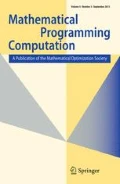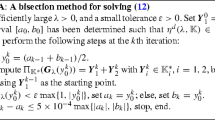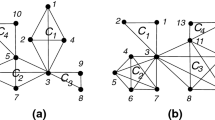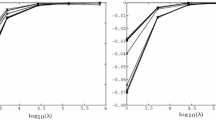Abstract
It has recently been shown (Burer, Math Program 120:479–495, 2009) that a large class of NP-hard nonconvex quadratic programs (NQPs) can be modeled as so-called completely positive programs, i.e., the minimization of a linear function over the convex cone of completely positive matrices subject to linear constraints. Such convex programs are NP-hard in general. A basic tractable relaxation is gotten by approximating the completely positive matrices with doubly nonnegative matrices, i.e., matrices which are both nonnegative and positive semidefinite, resulting in a doubly nonnegative program (DNP). Optimizing a DNP, while polynomial, is expensive in practice for interior-point methods. In this paper, we propose a practically efficient decomposition technique, which approximately solves the DNPs while simultaneously producing lower bounds on the original NQP. We illustrate the effectiveness of our approach for solving the basic relaxation of box-constrained NQPs (BoxQPs) and the quadratic assignment problem. For one quadratic assignment instance, a best-known lower bound is obtained. We also incorporate the lower bounds within a branch-and-bound scheme for solving BoxQPs and the quadratic multiple knapsack problem. In particular, to the best of our knowledge, the resulting algorithm for globally solving BoxQPs is the most efficient to date.
Similar content being viewed by others
References
Anderson E., Bai Z., Bischof C., Blackford S., Demmel J., Dongarra J., Du Croz J., Greenbaum A., Hammarling S., McKenney A., Sorensen D.: LAPACK Users’ Guide. Society for Industrial and Applied Mathematics, Philadelphia (1999)
Anstreicher K.M.: Recent advances in the solution of quadratic assignment problems. Math. Program. (Ser. B) 97(1–2), 27–42 (2003)
Berman A., Rothblum U.G.: A note on the computation of the CP-rank. Linear Algebra Appl. 419, 1–7 (2006)
Bomze I.M., de Klerk E.: Solving standard quadratic optimization problems via linear, semidefinite and copositive programming. J. Glob. Optim. 24(2), 163–185 (2002) Dedicated to Professor Naum Z. Shor on his 65th birthday
Bomze I.M., Dür M., de Klerk E., Roos C., Quist A.J., Terlaky T.: On copositive programming and standard quadratic optimization problems. J. Glob. Optim. 18(4), 301–320 (2000) GO’99 Firenze
Burer S.: On the copositive representation of binary and continuous nonconvex quadratic programs. Math. Program. 120, 479–495 (2009)
Burer S., Vandenbussche D.: Solving lift-and-project relaxations of binary integer programs. SIAM J. Optim. 16(3), 493–512 (2006)
Burer S., Vandenbussche D.: Globally solving box-constrained nonconvex quadratic programs with semidefinite-based finite branch-and-bound. Comput. Optim. Appl. 43(2), 181–195 (2009)
Burkard R.E., Karisch S., Rendl F.: QAPLIB—a quadratic assignment problem library. Eur. J. Oper. Res. 55, 115–119 (1991)
Caprara A., Pisinger D., Toth P.: Exact solution of the quadratic knapsack problem. Inf. J. Comput. 11(2), 125–137 (1999) Combinatorial optimization and network flows
de Klerk E., Pasechnik D.V.: Approximation of the stability number of a graph via copositive programming. SIAM J. Optim. 12(4), 875–892 (2002)
de Klerk E., Sotirov R.: Exploiting group symmetry in semidefinite programming relaxations of the quadratic assignment problem. Math. Program. 122(2 Ser. A), 225–246 (2010)
Helmberg C., Rendl F., Weismantel R.: A semidefinite programming approach to the quadratic knapsack problem. J. Comb. Optim. 4(2), 197–215 (2000)
ILOG, Inc.: ILOG CPLEX 9.0, User Manual (2003)
Jansson C., Chaykin D., Keil C.: Rigorous error bounds for the optimal value in semidefinite programming. SIAM J. Numer. Anal. 46(1), 180–200 (2007)
Moreau J.-J.: Décomposition orthogonale d’un espace hilbertien selon deux cônes mutuellement polaires. C. R. Acad. Sci. Paris 255, 238–240 (1962)
Murty K.G., Kabadi S.N.: Some NP-complete problems in quadratic and nonlinear programming. Math. Program. 39(2), 117–129 (1987)
Parrilo, P.: Structured semidefinite programs and semi-algebraic geometry methods in robustness and optimization. PhD thesis, California Institute of Technology (2000)
Pisinger D.: The quadratic knapsack problem—a survey. Discret. Appl. Math. 155(5), 623–648 (2007)
Pisinger D., Rasmussen A., Sandvik R.: Solution of large-sized quadratic knapsack problems through aggressive reduction. Inf. J. Comput. 19(2), 280–290 (2007)
Povh J., Rendl F.: Copositive and semidefinite relaxations of the quadratic assignment problem. Discret. Optim. 6(3), 231–241 (2009)
Povh J., Rendl F., Wiegele A.: A boundary point method to solve semidefinite programs. Computing 78(3), 277–286 (2006)
Sahinidis N.V.: BARON: a general purpose global optimization software package. J. Glob. Optim. 8, 201–205 (1996)
Sarac, T., Sipahioglu, A.: A genetic algorithm for the quadratic multiple knapsack problem. In: Advances in Brain, Vision, and Artificial Intelligence, vol. 4729 of Lecture Notes in Computer Science, pp. 490–498. Springer, Heidelberg (2007)
Sturm J.F.: Using SeDuMi 1.02, a MATLAB toolbox for optimization over symmetric cones. Optim. Methods Softw. 11/12(1–4), 625–653 (1999)
Vandenbussche D., Nemhauser G.: A branch-and-cut algorithm for nonconvex quadratic programs with box constraints. Math. Program. 102(3), 559–575 (2005)
Wen Z., Goldfarb D., Yin W.: Alternating Direction Augmented Lagrangian Methods for Semidefinite Programming. Manuscript, Department of Industrial Engineering and Operations Research, Columbia University, New York (2009)
Zhao Q., Karisch S., Rendl F., Wolkowicz H.: Semidefinite programming relaxations for the quadratic assignment problem. J. Comb. Optim. 2, 71–109 (1998)
Zhao, X., Sun, D., Toh, K.: A Newton-CG augmented Lagrangian method for semidefinite programming. Preprint, National University of Singapore, Singapore, Mar (2008). To appear in SIAM Journal on Optimization
Author information
Authors and Affiliations
Corresponding author
Additional information
This research was partially supported by NSF Grant CCF-0545514.
Rights and permissions
About this article
Cite this article
Burer, S. Optimizing a polyhedral-semidefinite relaxation of completely positive programs. Math. Prog. Comp. 2, 1–19 (2010). https://doi.org/10.1007/s12532-010-0010-8
Received:
Accepted:
Published:
Issue Date:
DOI: https://doi.org/10.1007/s12532-010-0010-8




